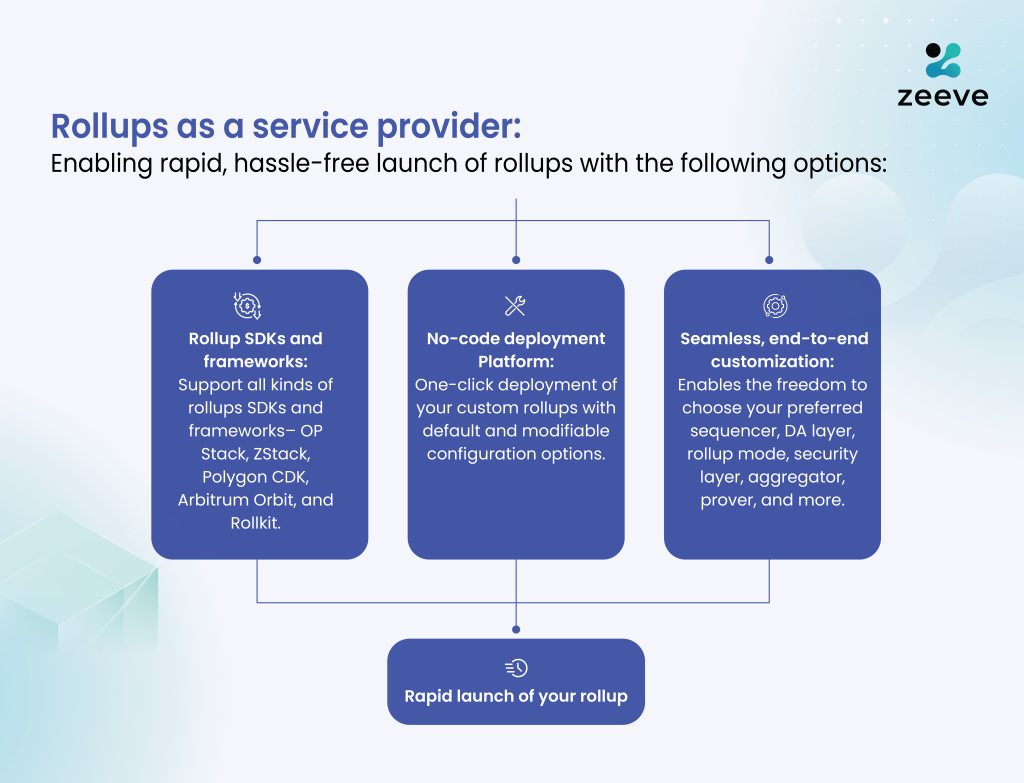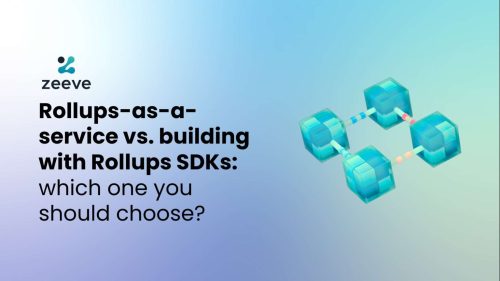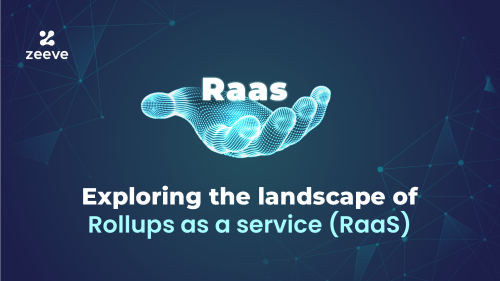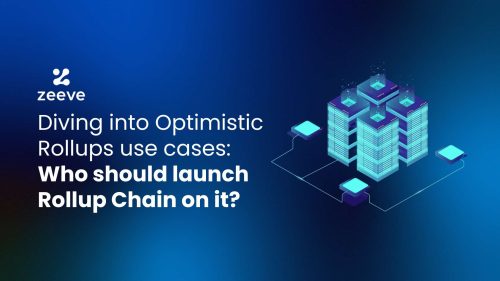
What should you look for in a Rollups-as-a-service (RaaS) provider?
As more web3 projects realize that rollups are a viable solution for scaling Layer-1 blockchains, rollups-as-a-service platforms become increasingly popular. But, if you are not aware of the technicalities around the rollup design, the decision to choose a reliable Raas can be challenging. This article explains all the key points related to rollups and rollups-as-a-service providers, enabling you to make an informed decision.
Who are Rollups-as-a-service (RaaS) service providers?
Before we learn about RaaS providers, let’s first understand what Rollups-as-a-service is. RaaS refers to an all-inclusive rollup stack that replaces the SDKs and framework-based approach of launching rollups with a simplified, one-click deployment process. You can get an in-depth overview of rollups-as-service from our dedicated blog linked here: A Deep Dive into Rollups-as-a-service (RaaS)
Speaking about rollups-as-a-service providers again, these are the businesses that offer rollup-as-a-service platforms. With raas, anyone can launch rollups on a production-ready infrastructure based on pay-per rollup approach. Meaning that the Rollups-as-a-service provider will provide a platform for seamless deployment of rollups. Projects using those rollups do not have to manage anything on their end, except for deploying and configuring the rollup– that too via a low-code panel.

Key considerations for choosing Rollups-as-a-service (RaaS) provider
Following are key aspects to consider while choosing a Rollups-as-a-service (RaaS) provider for your project. These are all high-level considerations– all related to rollup, but you always have to keep in mind the general considerations such as brand reputation, client satisfaction records, team size, and similar points. Now, let’s dive in:
1- Scalable & Robust Infrastructure:
Autoscaling RPCs- The RaaS platform you choose, it must offer autoscaling RPCs that can adapt to the varying needs of your network’s data volume and adjust its capacity accordingly. Meanwhile, it should also handle heavy RPC requests without creating any downtime.
High Availability Sequencers and prover – Sequencer play a critical role in aggregating transactions and processing them off-chain from the L1 main network, hence, its high availability and performance is important. Any downtime can result in slow processing of transactions, thereby causing interruption to the user experience and overall RaaS platform. Same goes with the prover, it must be robust enough to uninterruptably generate proofs for all the batched transaction so that the whole process remains streamlined.
Robust DA layer- RaaS platforms should offer the options to choose a viable DA layer from various options like Celestia and Avail. By choosing a robust DA layer, you ensure that your rollup network can access and verify the entire transaction data, thereby maintaining the chain’s transparency, security, and data integrity.
2- Configuration options:
General rollups and application-specific rollups– you can choose any. Like, if you go for the first option– the default configuration available in any Raas platform will work. But to fully customize your rollup, you should be able to choose all the configurations important for your dApp-specific rollup.
For example, if you are deploying a CDK chain, then whatever the configuration Polygon CDK supports, it must be there on your Raas platform. These components can be a specific type of sequencer, aggregator, prover, DAC, wallets, bridges, validums, and more.
3-Security and data privacy aspects:
Security is something that is vital for enterprises. Following are the parameters you should consider:
GDPR Compliance- Choosing a GDPR-compliant RaaS platform will ensure that your personal data is collected and utilized as per the strict standards set by the European Union and European Economic Area. Therefore, privacy and data integrity is preserved, leaving no chance of non-consensual data processing and further disputes.
ISO/IEC and SOC2– International Organization for Standardization/International Electrotechnical Commission, or ISO/IEC is a globally recognized, auditable security standard that establishes, implements, and improves the information and data security system on a RaaS platform. Regarding SOC2, this allows the rollup-as-a-service providers to manage all the user data securely while ensuring complete privacy.
DDOS protection– Denial of service or DDOS protection is essential for any RaaS platform to shield against various types of attacks– application layer attacks, protocol attacks, and volumetric attacks due to high traffic congestion and slow servers.
DDOS protection in a rollup service ensures that transactions continue even when the network goes offline for some time.
4- Protocol specifications:
RaaS platforms are considered highly feasible because of their support for diverse L1 and L2 protocols. That’s beause dApps may want to launch rollup as Layer-2 for any Layer-1 blockchain like Ethereum. Also, they can launch rollup as Layer-2 to scale existing L2s like Polygon, Arbitrum, or Optimism.
5-Support for Tooling & frameworks:
Rollup-related tools- When selecting a Raas provider, ensure they provide you with comprehensive tools that simplify the rollup deployment process. These tools can include bridges for cross-chain interoperability, dedicated explorers, wallets, testnet faucets, and data indexing solutions.
Visibility & rollup management tools- Seek high-end visibility tools in your Raas platform to be able to:
- View and manage your rollup’s smart contracts and wallets’s transaction happening on L2 & L2 networks.
- Get detailed insights on your node, monitor their health, and optimize the performance.
- View the logs of all the core components like wallets, sequencers, aggregator, etc, and receive real-time alerts about the changes.
- Get a full account and access control to see what’s happening on your rollup network and get the ease of making improvements as needed.
Interoperability tools– Apart from cross-chain bridge, a viable RaaS solution should support a range of other inter-rollup interoperability tools such as atomic swaps, oracles, relates, and protocol-based technology like Cross-Chain Interoperability Protocol (CCIP).
6- Analytical reporting:
Always check if your rollup-as-a-service provider can offer frequent reporting within the Raas platform. Note that reporting is different from monitoring as it includes both– monitoring + actionable analytics-rich reports about your rollup setup itself. The report can be based on network-level, security-level, blockchain-level.
7- Flexibility of services:
Flexible cloud deployment option- Along with the option to use RaaS-managed cloud, a rollup-as-a-service platform must allow users to bring their own cloud. Let’s say, if you already have a robust cloud setup in place from any provider, be it AWS, DigitalOcean, GCP, or Tencent Cloud– using that same cloud for rollup deployment can be a great option to save cost, resources and additional effort of setting up cloud once again.
On-demand integrations- Integration enhances the functionality of rollups; hence, choose a rollups-as-a-service provider that allows seamless integration for a range of products and services.
For instance, you can integrate high-quality debugging and analytics tools from external sources, enabling better transparency and performance optimization on your rollup network.
Hassle-free migration- Besides deploying a new rollup, a Raas platform should also allow for effortless migration of your existing L2 or L2 to a rollup-based ecosystem. A good migration service is one which does not require you to do major modifications in the smart contract logic, Opcode, or the underlying infrastructure. Or even if it’s required, it is handled well off by an expert team.
8- RaaS Architecture:
Easy Rollup Implementation UI- Rollup-as-a-service is designed to remove the technical complexity from the rollup launch process, therefore an ideal Raas platform should offer a simple and easy-to-understand rollup deployment or implementation UI. This allows everyone– startups, enterprises, and independent developers to build a rollup and switch to production faster easily.
9- Consulting:
Expert support & Guidance- Having a powerful, user-friendly Raas platform is not enough. It needs to be coupled with expert consultation and Guidance.
A trusted Raas provider should address all your infrastructural considerations and configurations, such as what type of rollup is suitable for your project– it can be a ZK rollup , validium, or OP rollup, which framework you should opt– Opstack, Arbitrum Orbit, ZkStack, CDK, or will you get 24/7 technical assistance. The consultant should be able to understand all your requirements and provide relevant solutions, making you feel confident about choosing their service.
Project estimates with quote- Your Rollups-as-a-service provider should be able to quote the cost of launching rollup and its maintenance afterwards. The quote must include everything– infrastructure cost, RPCs, and external integrations. Plus, the estimated time of completion allows you to plan the launch of your rollup project. Therefore, both these factors should be considered.
10- Community-connectivity & Partnership:
Partnership with Rollup protocols- Having a partnership is a good sign for the service’s reliability. Hence, while selecting your rollup implementation partner, it’s better to check their strategic partnership with protocols.
Let’s say if you are interested in building a CDK chain, then the Rollups-as-a-service provider should be a Polygon preferred CDK implementation partner. Likewise, for Hyperchains, partnership should be with the ZkSync ecosystem.
Support for modular services- An ideal Raas provider should have the flexibility to support modular services for building their sovereign rollups not just smart contract rollups. For example, the raas platform can support external (third-party) data availability networks, decentralized sequencer services, and provers. This allows enterprises to build an independent rollup using their preferred services and stack.

Benefits of choosing the right Rollups-as-a-service provider
Faster time-to-market: The ideal RaaS provider typically offers all the well-organized infrastructure and tools on the RaaS platform itself so that there’s no need for external integration or service addition. This approach streamline the entire rollup launch process and meanwhile decrease the overall cost significantly.
No compromise in security: Reliable RaaS providers ensure that their Rollup stack adheres to the relevant security standards such as rigorous SLA, GDPR, and Service Organization Control (SOC) audit compliance.
100% service satisfaction: Having a high level of service satisfaction is important to ensure the rollup launch goes smoothly, as expected. Plus, there should not be any technical or performance-related issues that can impact the associated dApp’s adoption.
Choose Zeeve as your preferred Raas provider
Zeeve offers a modular rollup-as-a-service (RaaS) stack for building fully customized Layer-2 and Layer-3 rollups. Zeeve currently offers Polygon CDK sandbox—a one-click deployment tool for launching custom CDK chain. Soon, Zeeve will offer similar RaaS stack for launching Zksync era hyperchains and Arbitrum Orbit.
And, for a successful launch, Zeeve will provide you everything– from scalable infrastructure, RPC nodes, support for explorers, cross-chain bridges, to data indexers.
Based on your project-based requirements, you can choose Polygon CDK, Opstack, Zkstack, Arbitrum Orbit, or any relevant stack to build your custom rollup – be it smart contract rollup or sovereign rollup. Further, Zeeve ensures the reliability of service with enterprise SLA, 99.9% uptime, ISO, SOC 2 Type II, and GDPR compliance.
For more information on how Zeeve is simplifying rollup launch as a trusted raas-as-a-service provider, get in touch with our expert consultants. You can drop us an email on this page or schedule one-to-one call for a detailed discussion.







Responses